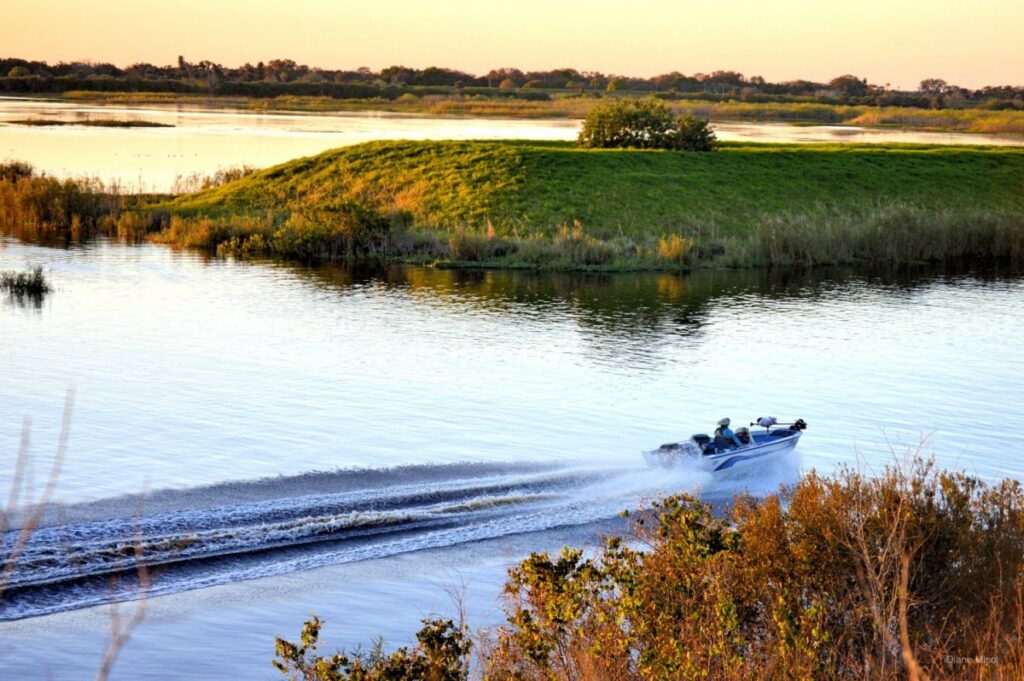Navigating Ambassador Marketing
as a Fishing Brand
Taking Ambassador Marketing to The Next Level
Influencer marketing, or the use of ambassadors & pro-staff, has become a core pillar in many fishing brands’ marketing playbooks to increase sales. Whether you’re tapping into the top category of anglers (ie Pro’s & Tournament) through an annual pro staff relationship, partnering with small to mid-tier ambassadors for one-off campaigns, or providing free & discounted products to college kids, amateurs or young, up-and-coming anglers to garner incremental exposure, the partnership opportunities are seemingly endless.
One thing for certain, however, is that a brand can easily use up valuable resources executing ambassador campaigns. Considering these realities, it can be challenging from a brand perspective to figure out if the potential value derived from these partnerships is truly worth the investment.
In this article, we’ll explore how layering in paid media can take your ambassador marketing to the next level. We’ll cover key areas to enhance your campaigns, from assessing the effectiveness of ambassador partnerships to leveraging niche media. Specifically, we will dig into the following aspects to ensure you & your brand get the most from your marketing efforts:
- Pros & Cons
- Generational Gap
- Platform Optimization
- Niche Media Analysis
- Content Amplification
- Performance Measurement
Pros
Targeted Audience Reach:Collaborating with ambassadors allows fishing brands to reach a highly targeted audience that is more likely to be receptive to your products or services.
Authenticity and Trust: Moreso than traditional advertising, followers trust ambassadors’ opinions and are more likely to consider products or services endorsed by them.
Localized Content: Ambassadors provide authentic, localized content that highlights your brand’s success in their region, making your product feel tailored and credible. Local endorsement and expertise resonate with regional audiences.
Social Proof: Social media platforms are a conduit for engagement. Having followers see ambassadors use your brand’s product reinforces credibility which can influence purchasing decisions.
Cons
Over-Commercialization: Exclusive paid deals can make ambassadors’ content seem repetitive. Frequent non-exclusive promotions can overwhelm followers and make their content appear too commercial, reducing credibility.
Limited Control: While brands often vet ambassadors and can drop them for inappropriate posts, managing them to meet contractual deliverables and ensuring consistent quality and alignment with brand messaging can be challenging.
Authenticity Concerns: Some followers may perceive influencer partnerships as inauthentic or insincere, especially if the collaboration feels forced or lacks transparency.
Cost & ROI Challenges: Partnering with ambassadors can strain tight marketing budgets, and assessing the true value and ROI of these ambassador campaigns can be complex and uncertain.
Beyond the above-mentioned pros and cons, fishing brands must carefully vet and select ambassadors who genuinely resonate with their brand values and audience. Additionally, it is crucial to adhere to disclosure and transparency regulations in all advertising and media campaigns to avoid legal repercussions, such as fines and penalties from regulatory bodies, as well as potential lawsuits from consumers and competitors.
Generational Gap
The variance in the impact of social media ambassadors on brand purchases across different age groups sheds light on the evolving landscape of consumer behavior and marketing trends.
There is a relatively even split between older and younger generations of anglers. Not including children, 52% of those who have participated in some type of fishing (fly/fresh/salt, etc.) in the last 12 months are 45 years or older, while 48% are between the ages of 18 and 44.
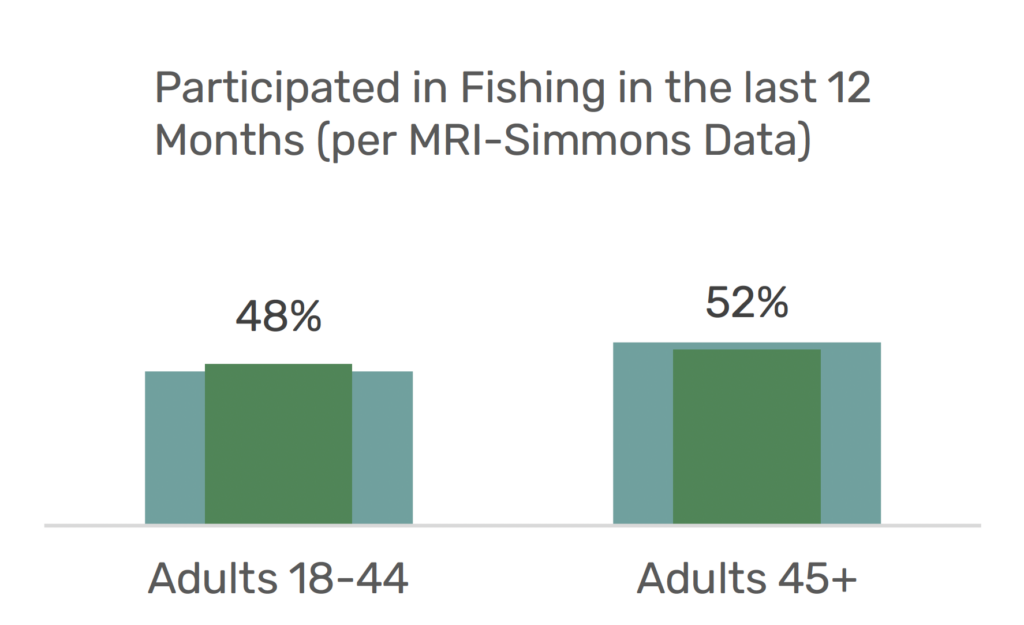
Among individuals aged 18 to 44, a significant 19% acknowledged that brand ambassadors exerted some level of influence on their purchasing decisions. This demographic, often referred to as Millennials and Generation Z, has grown up in the digital age, where social media platforms are integral parts of daily life, shaping perceptions and preferences. For these younger fishing enthusiasts, ambassadors serve as trusted sources of recommendations and trends, with their curated content often swaying purchasing choices in various product categories.
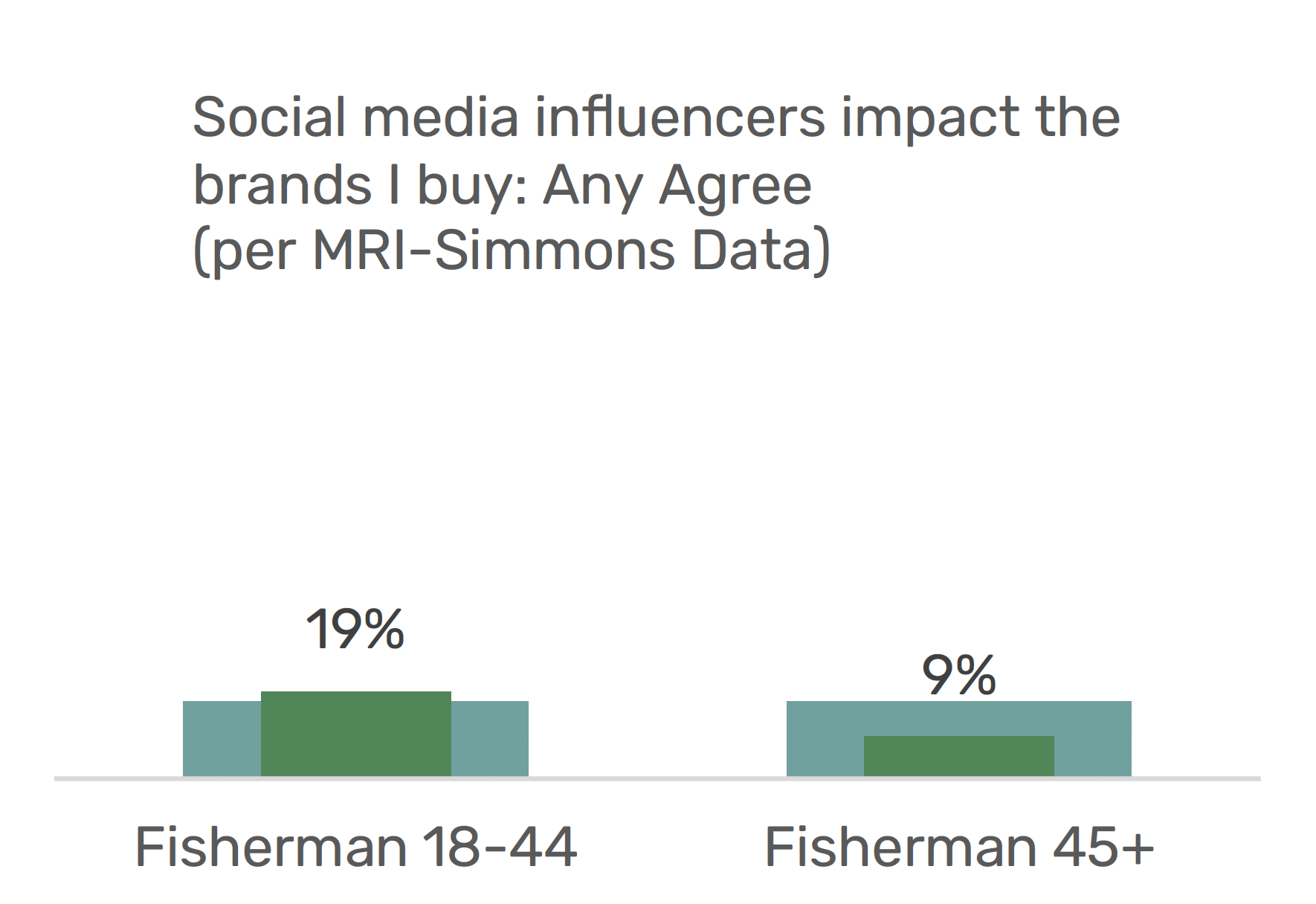 Conversely, among those aged 45 and older, who again make up more than half of anglers, the influence of social media ambassadors appears less pronounced, with only 9% admitting to being impacted by their content. This older demographic cohort, sometimes categorized as Generation X and Baby Boomers, may have different consumption habits and sources of information. Traditional advertising channels, word-of- mouth recommendations, and personal experiences might hold greater sway in shaping their brand perceptions and purchase decisions.
Conversely, among those aged 45 and older, who again make up more than half of anglers, the influence of social media ambassadors appears less pronounced, with only 9% admitting to being impacted by their content. This older demographic cohort, sometimes categorized as Generation X and Baby Boomers, may have different consumption habits and sources of information. Traditional advertising channels, word-of- mouth recommendations, and personal experiences might hold greater sway in shaping their brand perceptions and purchase decisions.
The divide in ambassador impact underscores the importance for brands to tailor their marketing strategies to resonate with diverse audience segments. While younger anglers may be receptive to ambassador collaborations and social media campaigns, older demographics may require more traditional marketing approaches that emphasize product quality, reliability, and brand reputation. As the digital landscape continues to evolve, understanding and adapting to these generational differences in consumer behavior will be key for brands striving to remain relevant and influential in an increasingly competitive marketplace.
Platform Optimization
The generational gap is not only apparent with the following of ambassadors but also in social media usage where ambassador content is generally consumed. Of those that have gone fishing in the last 12 months, 90% of adults 18-44 compared to 81% of adults 45+ use social media monthly. In addition, a larger percentage of the younger generations use a variety of social media platforms. Facebook is the only platform where reach across both age groups is significant and comparable.
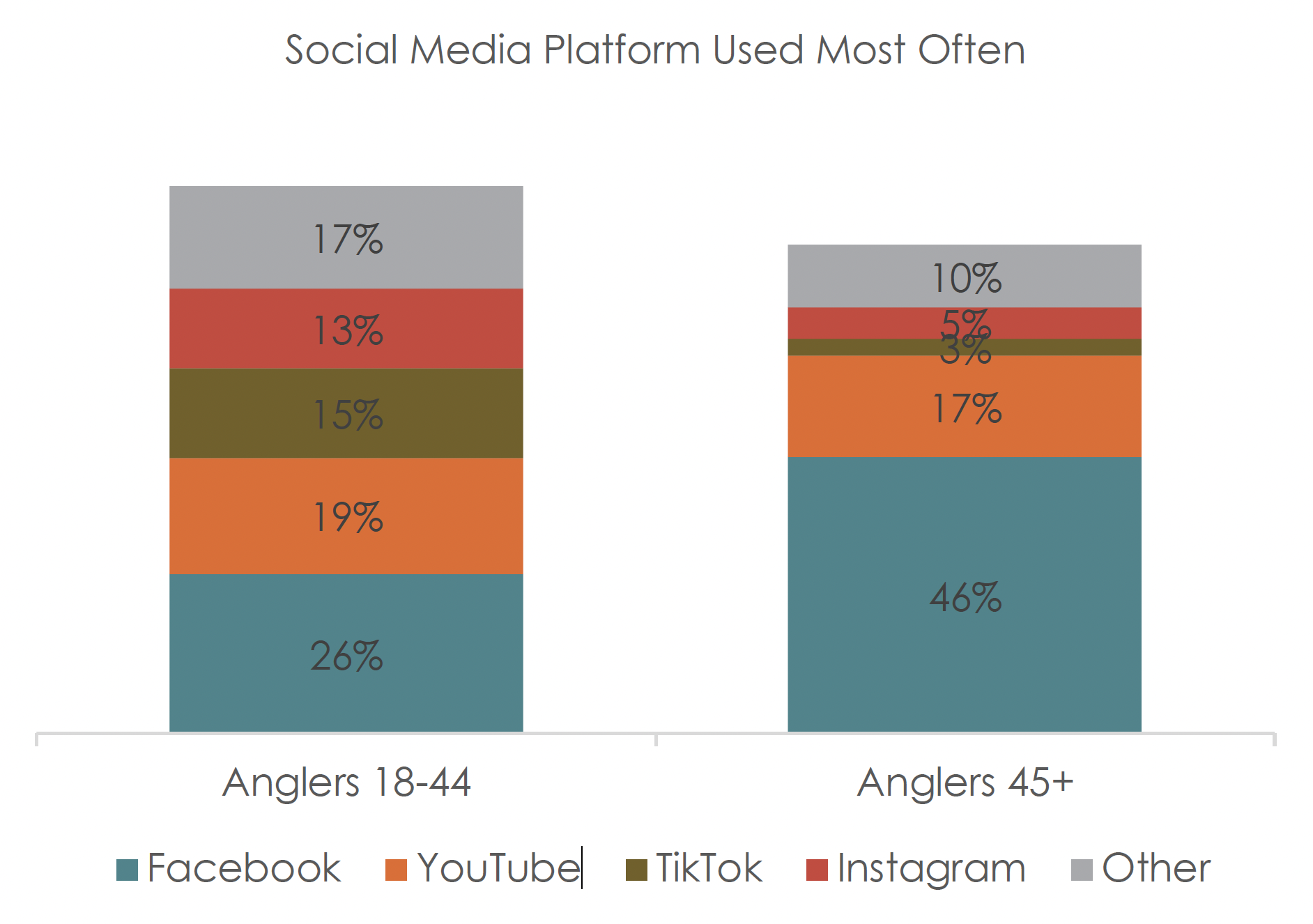 The platforms most used by the younger anglers vary wildly across Facebook, YouTube, TikTok, and Instagram, whereas the older anglers predominately use Facebook, followed by YouTube. When building out these programs, platform preference by demographic along with the ambassador’s following by platform should be a strategic consideration to maximize reach.
The platforms most used by the younger anglers vary wildly across Facebook, YouTube, TikTok, and Instagram, whereas the older anglers predominately use Facebook, followed by YouTube. When building out these programs, platform preference by demographic along with the ambassador’s following by platform should be a strategic consideration to maximize reach.
Beyond audience, content format and style must be adapted to suit the strengths of each platform. For example, on Instagram, the focus should be on visually appealing images and short videos that showcase fishing experiences, while on YouTube a longer-form video providing in-depth tutorials or product reviews could resonate. The same goes when selecting your ambassador and understanding each one’s strength and focus when it comes to channels and content type. A mix of anglers who have content concentrated across new product reviews, DIY, lake & water reports, POV fishing shorts & more thematic long form will help ensure a wider reach across various types of angler.
Niche Media Analysis
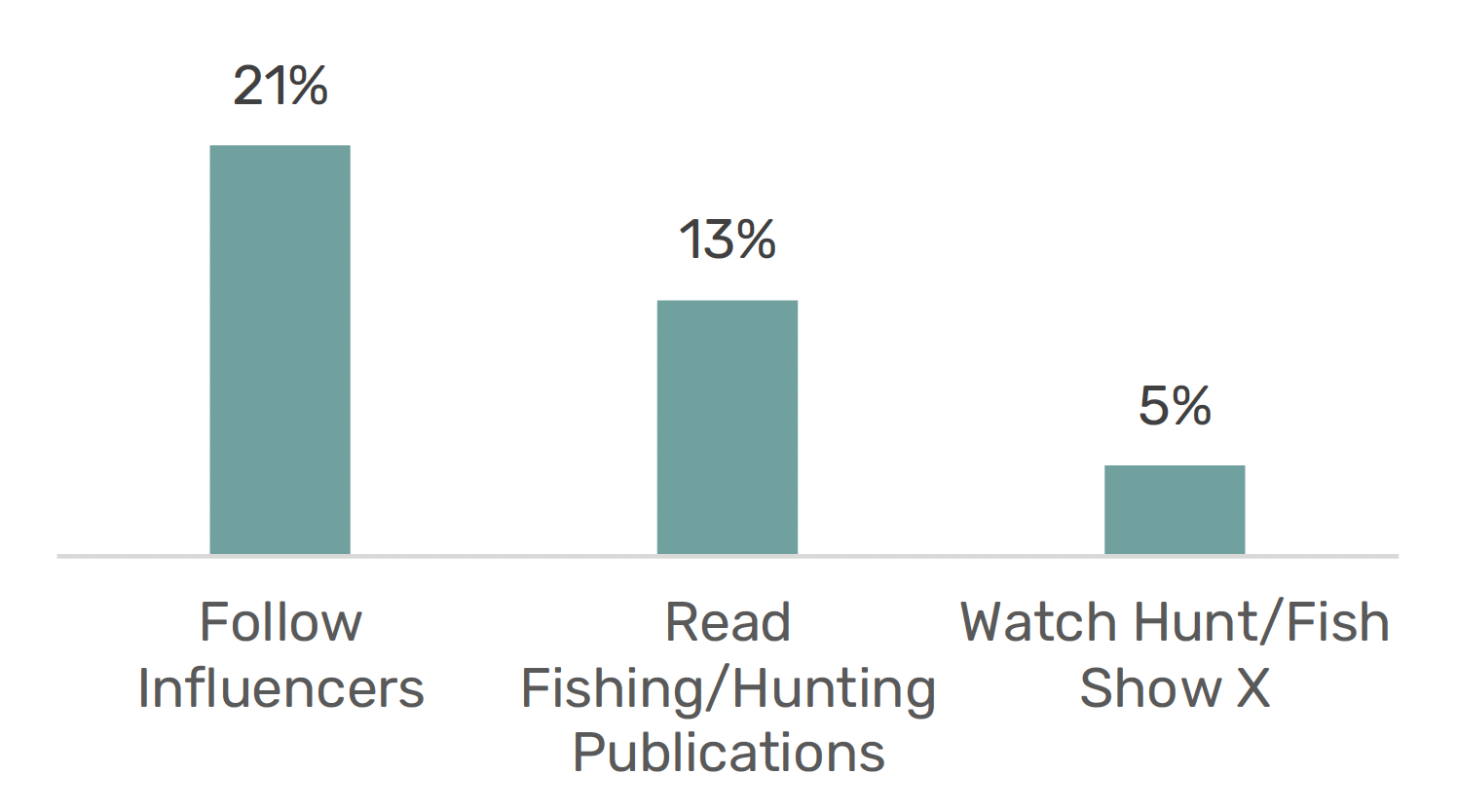 Just like running ads in fishing and hunting publications or a 30 second spot on an endemic TV show, there is a maximum threshold of reaching those who have gone fishing in the last 12 months, so too does an ambassador program where only 21% have indicated that they follow influencers (not category specific) on social media.
Just like running ads in fishing and hunting publications or a 30 second spot on an endemic TV show, there is a maximum threshold of reaching those who have gone fishing in the last 12 months, so too does an ambassador program where only 21% have indicated that they follow influencers (not category specific) on social media.
Make no mistake that running ads in niche media channels or having partnerships with category ambassadors is an important strategy to reach a highly interested and engaged audience, leveraging their authenticity and credibility, and delivering your brands’ message in a contextually relevant environment.
On the other hand, relying solely on these strategies may indeed limit your reach in the broader fishing category. For example, niche publications and category ambassadors primarily cater to a specific subset of anglers (ie bass, salt, fly, etc.) who are already engaged and knowledgeable about the sport. To reach the a larger audience within the fishing category, brands can benefit by expanding their reach into less specific channels. This requires adopting marketing strategies that appeal to a wider audience, including casual anglers, beginners, and those who may be interested in fishing but are not actively engaged in the fishing community.
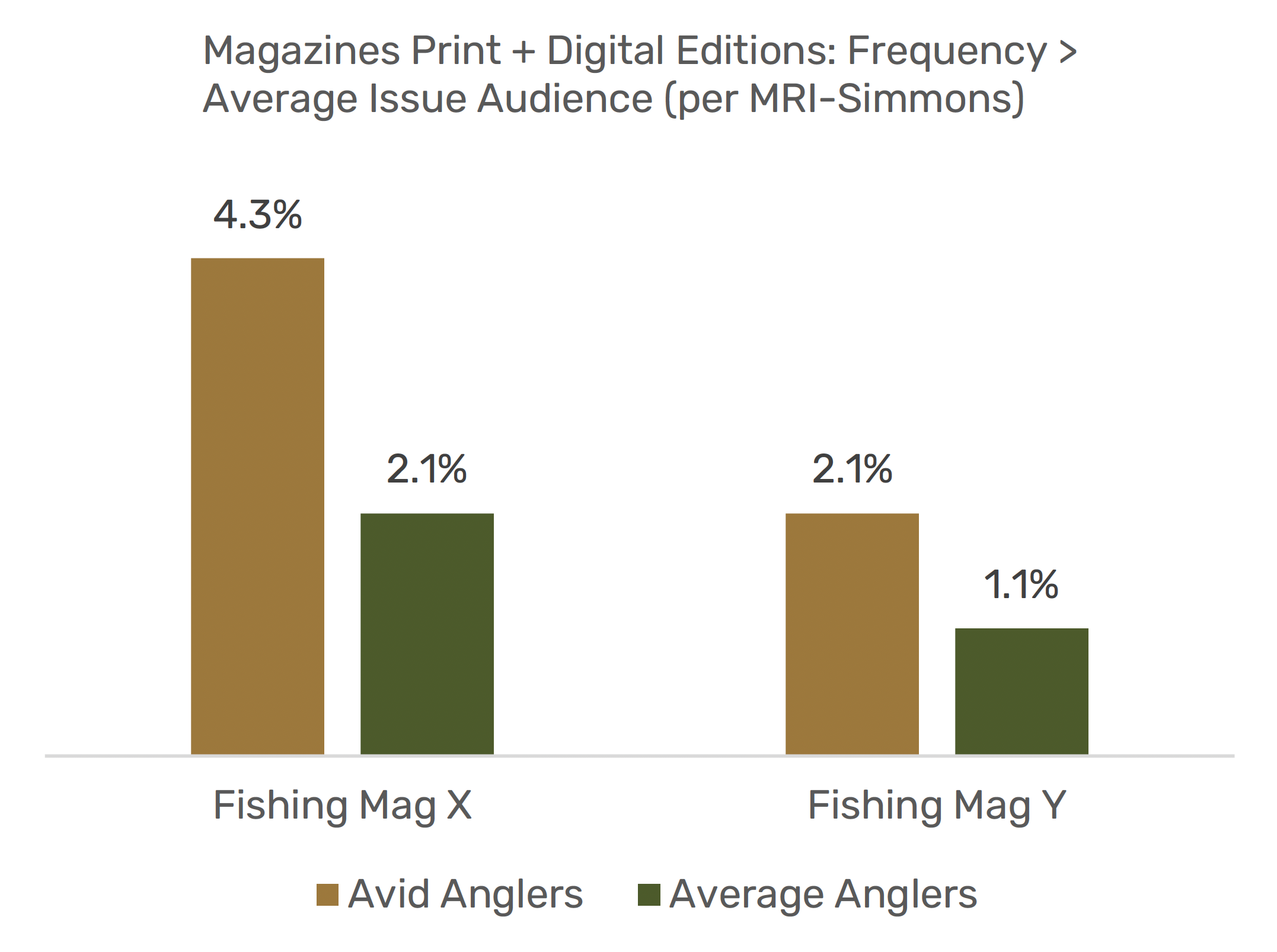 Analyzing the data between those who fish two times a month or more (Avid Anglers) compared to those who fish once a month or less (Average Anglers), reveals a notable trend where the viewership of niche publications among Avid anglers is markedly higher. This disparity underscores that there is a distinct preference and behavior between avid enthusiasts, who actively seek out specialized fishing/boating content, and casual/average anglers, who engage with fishing, boating and related media less frequently but still to some degree.
Analyzing the data between those who fish two times a month or more (Avid Anglers) compared to those who fish once a month or less (Average Anglers), reveals a notable trend where the viewership of niche publications among Avid anglers is markedly higher. This disparity underscores that there is a distinct preference and behavior between avid enthusiasts, who actively seek out specialized fishing/boating content, and casual/average anglers, who engage with fishing, boating and related media less frequently but still to some degree.
While niche media channels and ambassador partnerships can be highly effective in reaching a targeted and engaged audience within the fishing community, concerns about scale inevitably arise. The challenge lies in the limited reach of these strategies compared to the vast audience of 50M+ individuals who have fished in the last 12 months. While magazines and ambassadors may attract significant attention within their respective niches, their reach may not extend far beyond dedicated fishing enthusiasts. This raises questions about the ability of these strategies to effectively engage with the broader masses within the fishing category. As brands strive to maximize their impact and connect with a larger audience, they must carefully consider how to balance the benefits of niche targeting with the need for broader reach and appeal in their marketing efforts.
At the end of the day, niche channels, while valuable, only represent a fraction of the overall media landscape. Fishing brands need to diversify their marketing mix by incorporating a range of channels, including digital and traditional media, to increase brand visibility and recognition.

Content Amplification
In the dynamic world of fishing, where authenticity and community trust are paramount, leveraging ambassador content for broader paid advertising campaigns presents a compelling opportunity for brands. By repurposing content created by trusted fishing ambassadors, brands can amplify their reach and resonate more deeply with target audiences. However, this strategy requires careful navigation of legal considerations to ensure compliance and to protect all parties involved.
When brands want to use content produced by a paid social media ambassador for other paid advertising, several important factors must be considered to ensure legal compliance.
- Contract and Licensing Agreements: The contract with the ambassador must explicitly grant the brand the right to use the content for additional advertising purposes, which should specify duration, geographic scope, and channels where the content will be used. It should be clear if the brand has exclusive rights to the content or if the ambassador will retain any ownership or rights.
- Compensation: Additional ambassador compensation may be required if content is being used beyond the initial agreed-upon usage, which should be clearly defined in the contract.
- Content Adaptations and Modifications: Permission should be granted to make any modifications, edits, or adaptations to the ambassador’s content for use in different advertising formats.
- Disclosure and Compliance: FTC guidelines require the clear disclosure that ambassador content is sponsored when it is being repurposed for paid advertising, ensuring transparency and avoiding potential deception of consumers.
- Legal and Ethical Considerations: Due diligence should be made to verify that the content does not infringe on any third-party copyright or intellectual property rights. Ensure the content adheres to ethical advertising standards that will not mislead the consumer.
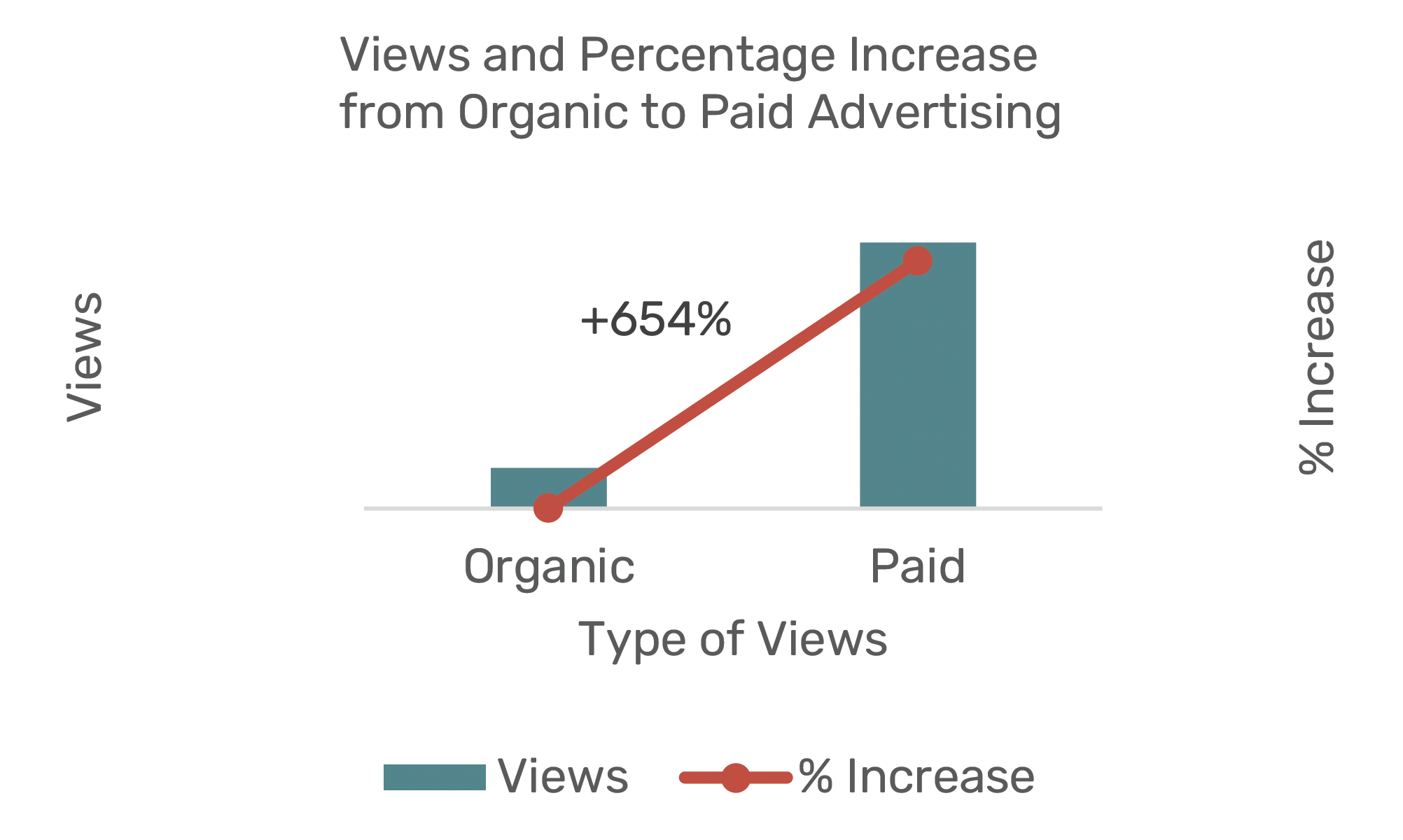 Extending reach beyond an ambassador’s organic following paired with the application of targeting to reach specific demographics, locations, and/or interests allow brands to enhance their marketing efforts, especially in a niche market like fishing. Watauga has successfully executed paid advertising extensions of ambassador content for brands with the goal of maximizing reach during limited time offer promotion periods. With the use of paid advertising, the campaign in this example from a Watauga Client saw a 654% increase in content views compared to the original organic exposure. This boost demonstrates the powerful impact that strategically leveraging paid promotions can have on brand visibility and engagement.
Extending reach beyond an ambassador’s organic following paired with the application of targeting to reach specific demographics, locations, and/or interests allow brands to enhance their marketing efforts, especially in a niche market like fishing. Watauga has successfully executed paid advertising extensions of ambassador content for brands with the goal of maximizing reach during limited time offer promotion periods. With the use of paid advertising, the campaign in this example from a Watauga Client saw a 654% increase in content views compared to the original organic exposure. This boost demonstrates the powerful impact that strategically leveraging paid promotions can have on brand visibility and engagement.
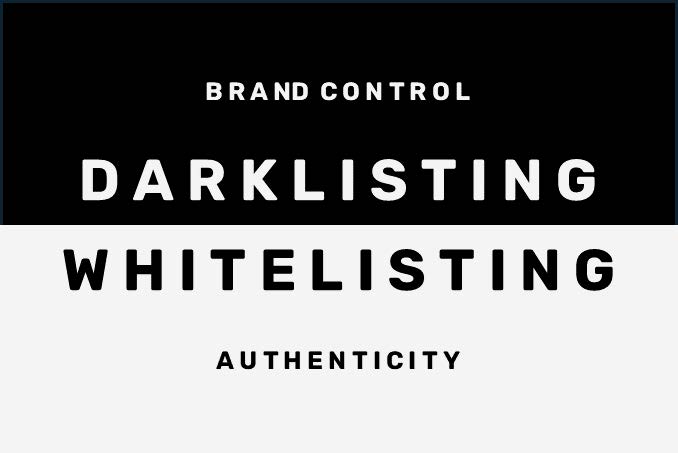 When activating paid advertising through ambassador content, brands can take one of two approaches. The first, referenced as darklisting, involves a brand commissioning creators to produce content, which is then submitted to the brand for distribution through the brand’s own advertising accounts. These ads appear under the brand’s name and account, even though they feature the ambassador’s likeness or content. On the contrary, whitelisting allows ambassadors to retain creative control and post content on their own social media accounts, which is then authorized for the brand to promote. Brands can turn these organic posts into ads by obtaining permission from the ambassador to use their content in advertising. Each approach offers distinct advantages and disadvantages, influencing how content is perceived and engaged with by the audience.
When activating paid advertising through ambassador content, brands can take one of two approaches. The first, referenced as darklisting, involves a brand commissioning creators to produce content, which is then submitted to the brand for distribution through the brand’s own advertising accounts. These ads appear under the brand’s name and account, even though they feature the ambassador’s likeness or content. On the contrary, whitelisting allows ambassadors to retain creative control and post content on their own social media accounts, which is then authorized for the brand to promote. Brands can turn these organic posts into ads by obtaining permission from the ambassador to use their content in advertising. Each approach offers distinct advantages and disadvantages, influencing how content is perceived and engaged with by the audience.
Darklisting provides brands with significant control over their campaigns, enabling precise targeting, budget management, and the facilitation of seamless consumer engagement. Ads run from the brand’s account can streamline interactions, making it easier for customers to explore and purchase products. However, this method lacks the ambassador’s organic audience reach, potentially reducing authenticity and impact. The ads can seem detached from the ambassador’s personal brand, making them appear more like traditional marketing rather than genuine endorsements.
Whitelisting leverages the ambassador’s established trust and engagement with their followers, making ads feel more genuine and relatable. It allows brands to benefit from the ambassador’s personal touch and organic reach, which can enhance the authenticity of the content. However, brands have less creative control, potentially leading to inconsistent messaging. This approach also requires ambassador cooperation, granting the brand permission to advertising rights.
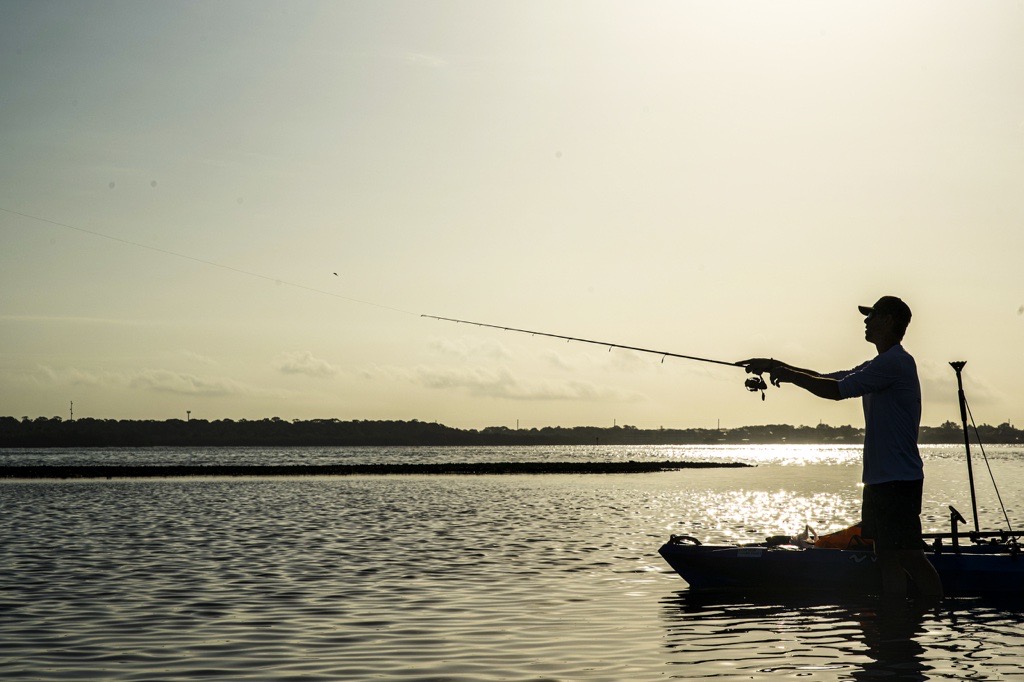 Many fishing brands leverage an ambassador strategy to organically extend their reach by having ambassadors share and tag branded content, which is then amplified through the brand’s own channels. Ultimately, the choice between darklisting and whitelisting, to further enhance the reach of this organic ambassador content through paid amplification, depends on striking a balance between brand control and authenticity in ambassador-led advertising initiatives. Darklisting excels in precise targeting and content management but may sacrifice the inherent credibility and organic reach of ambassador-driven content. In contrast, whitelisting thrives on authenticity and ambassador ownership of content, emphasizing trust and relatability with audiences. Brands must weigh these factors against their specific goals, desired consumer engagement levels, and the collaborative dynamics with ambassadors to achieve effective and impactful advertising strategies.
Many fishing brands leverage an ambassador strategy to organically extend their reach by having ambassadors share and tag branded content, which is then amplified through the brand’s own channels. Ultimately, the choice between darklisting and whitelisting, to further enhance the reach of this organic ambassador content through paid amplification, depends on striking a balance between brand control and authenticity in ambassador-led advertising initiatives. Darklisting excels in precise targeting and content management but may sacrifice the inherent credibility and organic reach of ambassador-driven content. In contrast, whitelisting thrives on authenticity and ambassador ownership of content, emphasizing trust and relatability with audiences. Brands must weigh these factors against their specific goals, desired consumer engagement levels, and the collaborative dynamics with ambassadors to achieve effective and impactful advertising strategies.
Performance Measurement
Tracking the performance of ambassador & pro-staff marketing programs for fishing, boating & marine electronics brands presents several challenges due to the unique nature of the fishing community and the dynamics of these types of partnerships.
Attribution is probably the most coveted metric while also being the most difficult to quantify given purchasing decisions in the fishing industry may involve multiple touchpoints across various channels in combination with offline and online sales. Unlike advertising that has a finite lifespan, ambassador content often continues to generate engagement and exposure over time. The long-term impact to awareness, consideration, or purchase intent can be challenging, especially as content may resurface months or even years after its initial publication.
While engagement metrics such as likes, comments, shares, and views provide a quantitative measure of how audiences interact with ambassador content, they do not necessarily reflect the quality or depth of that engagement. For fishing brands, understanding the nuances of engagement quality is crucial for evaluating the true impact of these campaigns.
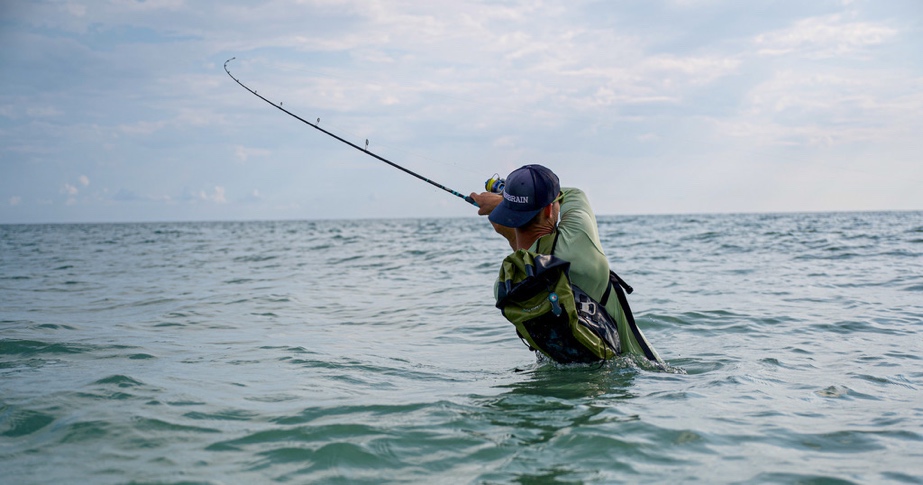 For a more direct link to attributable sales from ambassador content, brands can deploy unique tracking links, exclusive promo codes, or affiliate marketing partnerships. These approaches offer direct measurement of the return on investment (ROI), which allows brands to assess the effectiveness of their
For a more direct link to attributable sales from ambassador content, brands can deploy unique tracking links, exclusive promo codes, or affiliate marketing partnerships. These approaches offer direct measurement of the return on investment (ROI), which allows brands to assess the effectiveness of their
investment. In addition, by attributing sales to influencer content, brands can hold ambassadors accountable for their impact on driving purchases. This trackability can also contribute to campaign optimization where conversions from ambassadors, content types, or messaging strategies can be assessed and reallocated accordingly to maximize ROI.
While attributed sales provide valuable insights into the direct impact of ambassador content on driving purchases, there are several limitations to consider. Attributed sales can be constrained by narrow attribution windows that miss long-term or indirect effects. Issues like ambassador fraud, including fake followers, can distort metrics. Additionally, organic influence might be underrepresented if sales aren’t directly connected to tracked links or promo codes. Therefore, while useful, attributed sales should be complemented with other performance metrics to gain a comprehensive understanding of an ambassador campaign’s effectiveness.
Many factors can contribute to a consumer’s decision to purchase a product, sign up for a subscription, or fill out a form. It is not easy to isolate an ambassadors’ impact on a brand, and tracking the full journey of a consumer’s interaction with your brand to post conversion can be complex. Your brand can start off hoping to increase short-term conversions, but ambassador marketing should ultimately be quantified in brand awareness, customer satisfaction, and long–term customer loyalty.
Conclusion
Ambassador marketing in the fishing industry presents both opportunities and challenges for brands looking to engage with a diverse and passionate audience. While ambassador partnerships can offer targeted reach, authentic content, and valuable engagement, they also come with limitation in scalability, potential over-commercialization, and the complexities of managing ambassador relationships. Brands must carefully weigh the pros and cons, optimize platform use, and balance niche targeting with broader appeal to ensure their marketing strategies effectively hook both dedicated anglers and a wider audience. As the digital landscape evolves, adaptability and strategic foresight will be key to successful ambassador marketing in the fishing world.
To amplify your influencer marketing initiatives, Watauga Group can help you navigate the intricate landscape of ambassador partnerships in the fishing industry. Our approach encompasses optimizing your existing content strategy across platforms and executing innovative amplification techniques. Regardless of the approach, we will enhance your reach and engagement by strategically integrating ambassador content into broader paid campaigns. This approach not only magnifies the authentic voice of your ambassadors but also maximizes your investment by reaching beyond their organic followers. Together, we can craft a compelling narrative that captures the essence of your brand and hooks your audience with precision and impact.
You can find additional industry resources including our 2024 Outdoor Customer Growth Report.
